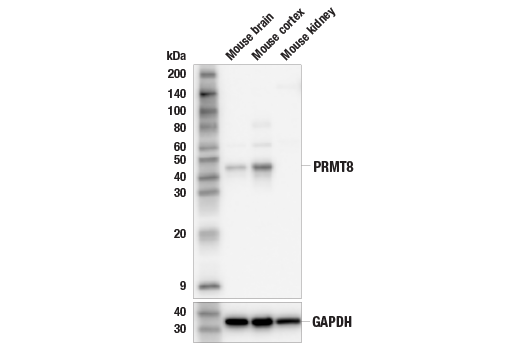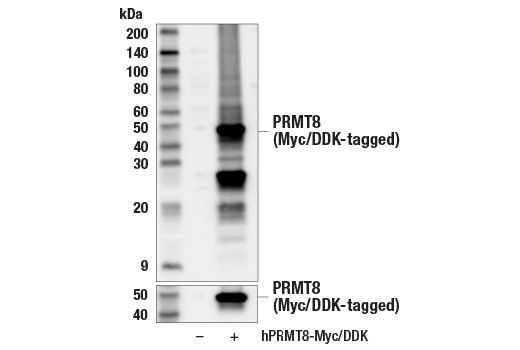WB
M
Endogenous
45
Rabbit IgG
#Q9NR22
56341
Product Information
Product Usage Information
| Application | Dilution |
|---|---|
| Western Blotting | 1:1000 |
Storage
Specificity / Sensitivity
Species Reactivity:
Mouse
Species predicted to react based on 100% sequence homology
The antigen sequence used to produce this antibody shares
100% sequence homology with the species listed here, but
reactivity has not been tested or confirmed to work by CST.
Use of this product with these species is not covered under
our
Product Performance Guarantee.
Human
Source / Purification
Monoclonal antibody is produced by immunizing animals with a synthetic peptide corresponding to residues surrounding Gly323 of human PRMT8 protein.
Background
Arginine methylation is a prevalent PTM found on both nuclear and cytoplasmic proteins. Arginine methylated proteins are involved in many different cellular processes, including transcriptional regulation, signal transduction, RNA metabolism, and DNA damage repair (1-3). Arginine methylation is carried out by the arginine N-methyltransferase (PRMT) family of enzymes that catalyze the transfer of a methyl group from S-adenosylmethionine (AdoMet) to a guanidine nitrogen of arginine (4). There are three different types of arginine methylation: asymmetric dimethylarginine (aDMA, omega-NG,NG-dimethylarginine), where two methyl groups are placed on one of the terminal nitrogen atoms of the guanidine group of arginine; symmetric dimethylarginine (sDMA, omega-NG,NG-dimethylarginine), where one methyl group is placed on each of the two terminal guanidine nitrogens of arginine; and monomethylarginine (MMA, omega-NG-methylarginine), where a single methyl group is placed on one of the terminal nitrogen atoms of arginine. Each of these modifications has potentially different functional consequences. Though all PRMT proteins catalyze the formation of MMA, Type I PRMTs (PRMT1, 3, 4, 6, and 8) add an additional methyl group to produce aDMA, while Type II PRMTs (PRMT5 and 7) produce sDMA. Methylated arginine residues often reside in glycine-arginine rich (GAR) protein domains, such as RGG, RG, and RXR repeats (5). However, PRMT4/CARM1 and PRMT5 methylate arginine residues within proline-glycine-methionine rich (PGM) motifs (6).
PRMT8 is a Type I PRMT closely related to PRMT1 and is expressed primarily in the brain. PRMT8 has a unique N-terminus that is myristoylated, which targets it to the plasma membrane (7). The N-terminal domain also is responsible for PRMT8 activity, and contains two automethylation sites that regulate affinity for AdoMet. (8,9). PRMT8 has been shown to be critical in neural development (10,11). In post-mitotic neurons, PRMT8 provides a protective role against double-stranded DNA breaks that accumulate with aging (12). Overexpression of PRMT8 has been shown to be associated with tau phosphorylation and neuroinflammation (13). PRMT8 is also expressed in stem cells and can control pluripotency and mesodermal fate through the PI3K/Akt/Sox2 axis (14,15).
- Bedford, M.T. and Richard, S. (2005) Mol Cell 18, 263-72.
- Pahlich, S. et al. (2006) Biochim Biophys Acta 1764, 1890-903.
- Bedford, M.T. and Clarke, S.G. (2009) Mol Cell 33, 1-13.
- McBride, A.E. and Silver, P.A. (2001) Cell 106, 5-8.
- Gary, J.D. and Clarke, S. (1998) Prog Nucleic Acid Res Mol Biol 61, 65-131.
- Cheng, D. et al. (2007) Mol Cell 25, 71-83.
- Lee, J. et al. (2005) J Biol Chem 280, 32890-6.
- Sayegh, J. et al. (2007) J Biol Chem 282, 36444-53.
- Dillon, M.B. et al. (2013) J Biol Chem 288, 27872-80.
- Lin, Y.L. et al. (2013) PLoS One 8, e55221.
- Simandi, Z. et al. (2015) Stem Cells 33, 726-41.
- Simandi, Z. et al. (2018) J Neurosci 38, 7683-7700.
- Ishii, A. et al. (2022) J Biochem 172, 233-243.
- Solari, C. et al. (2016) Biochem Biophys Res Commun 473, 194-199.
- Jeong, H.C. et al. (2017) Stem Cells 35, 2037-2049.
Species Reactivity
Species reactivity is determined by testing in at least one approved application (e.g., western blot).
Western Blot Buffer
IMPORTANT: For western blots, incubate membrane with diluted primary antibody in 5% w/v BSA, 1X TBS, 0.1% Tween® 20 at 4°C with gentle shaking, overnight.
Applications Key
WB: Western Blotting
Cross-Reactivity Key
H: human M: mouse R: rat Hm: hamster Mk: monkey Vir: virus Mi: mink C: chicken Dm: D. melanogaster X: Xenopus Z: zebrafish B: bovine Dg: dog Pg: pig Sc: S. cerevisiae Ce: C. elegans Hr: horse GP: Guinea Pig Rab: rabbit All: all species expected
Trademarks and Patents
使用に関する制限
法的な権限を与えられたCSTの担当者が署名した書面によって別途明示的に合意された場合を除き、 CST、その関連会社または代理店が提供する製品には以下の条件が適用されます。お客様が定める条件でここに定められた条件に含まれるものを超えるもの、 または、ここに定められた条件と異なるものは、法的な権限を与えられたCSTの担当者が別途書面にて受諾した場合を除き、拒絶され、 いかなる効力も効果も有しません。
研究専用 (For Research Use Only) またはこれに類似する表示がされた製品は、 いかなる目的についても FDA または外国もしくは国内のその他の規制機関により承認、認可または許可を受けていません。 お客様は製品を診断もしくは治療目的で使用してはならず、また、製品に表示された内容に違反する方法で使用してはなりません。 CST が販売または使用許諾する製品は、エンドユーザーであるお客様に対し、使途を研究および開発のみに限定して提供されるものです。 診断、予防もしくは治療目的で製品を使用することまたは製品を再販売 (単独であるか他の製品等の一部であるかを問いません) もしくはその他の商業的利用の目的で購入することについては、CST から別途許諾を得る必要があります。 お客様は以下の事項を遵守しなければなりません。(a) CST の製品 (単独であるか他の資材と一緒であるかを問いません) を販売、使用許諾、貸与、寄付もしくはその他の態様で第三者に譲渡したり使用させたりしてはなりません。また、商用の製品を製造するために CST の製品を使用してはなりません。(b) 複製、改変、リバースエンジニアリング、逆コンパイル、 分解または他の方法により製品の構造または技術を解明しようとしてはなりません。また、 CST の製品またはサービスと競合する製品またはサービスを開発する目的で CST の製品を使用してはなりません。(c) CST の製品の商標、商号、ロゴ、特許または著作権に関する通知または表示を除去したり改変したりしてはなりません。(d) CST の製品をCST 製品販売条件(CST’s Product Terms of Sale) および該当する書面のみに従って使用しなければなりません。(e) CST の製品に関連してお客様が使用する第三者の製品またはサービスに関する使用許諾条件、 サービス提供条件またはこれに類する合意事項を遵守しなければなりません。

